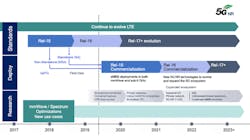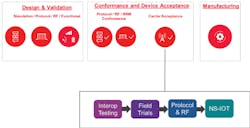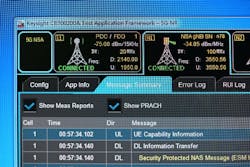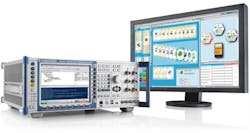Where Does 5G Conformance Testing Stand in 2020?
The 5G test and conformance era is far more challenging than 4G wireless amid a broad range of new services and technology paradigms. There’s a large matrix of test cases that vary widely, and these changes reinforce the importance of adequately validating the device performance on 5G networks as specified in the New Radio (NR) standard (Fig. 1).
The 5G conformance test spans RF characteristics, radio resource management (RRM), and communication protocol suites, and that calls for flexible test solutions that can eventually be customized for specific use cases and certification requirements. At the same time, it’s also critical that both chipsets and devices are rigorously tested under linear and nonlinear conditions across the entire workflow, from design validation to product manufacturing (Fig. 2).
There are other pressures as well when it comes to accelerating the conformance to advance 5G commercialization. For instance, network operators, as well as chipset and device manufacturers, are striving to ensure successful device testing and acceptance on the first attempt. But that’s easier said than done.
For starters, 5G conformance testing encompasses two technology realms: sub-6-GHz bands with new multiple-input multiple-output (MIMO) antenna systems and higher-frequency millimeter-wave (mmWave) bands with highly focused beamsteering. The conformance testing matrix further expands with different spectrums operating across the globe and the need for 5G devices to work in both non-standalone and standalone modes.
That calls for engineers to thoroughly test the parametric performance, physical-layer (PHY) characteristics, and protocol functionality of the device’s chipset using the same emulated network and communication channels employed by 5G carriers. The following section provides highlights of the extended matrix of 5G test cases that includes functional testing, negative testing, regression testing, KPI testing, data-throughput testing, and overall device performance testing.
5G Conformance Matrix
The conformance test requirements, as specified in the 3GPP 5G NR standard, include a wide range of RF demodulation and RRM test cases. And they can be validated by the Global Certification Forum (GCF) and PCS Type Certification Review Board (PTCRB), a certification platform comprised of the leading U.S. mobile operators.
Start with the Testing and Test Control Notation version 3 (TTCN-3) conformance testbed, a core language that 3GPP uses to specify different types of reactive system tests over a variety of communication ports. The TTCN-3 conformance use cases employ real user equipment (UE) and real hardware in the form of network simulators to verify 5G designs.
Next, RAN5, a workgroup within 3GPP, focuses on the conformance testing specification for the radio interface of UE devices. It’s organized in the RF subgroup and the signaling subgroup, respectively, and it encompasses both RF and RRM conformance tests. The RAN5 workgroup approves the Protocol Conformance Tests as defined in the 3GPP TS38.523 requirements.
The 5G conformance testing ranges from device R&D and design validation to conformance verification to carrier acceptance and manufacturing. Thus, the 5G mobile ecosystem is being streamlined from early prototyping to design validation to device manufacturing. Take, for example, the Chinese phone maker Oppo, which unveiled the 5G handset “Reno” in April 2019. It demonstrated the world’s first 5G signaling and data connection for a video call in November 2018 (Fig. 3).
According to James Kimery, director of wireless research at National Instruments (NI), assessing the performance of video and data delivery is crucial for 5G devices. It’s worth mentioning here that 5G device manufacturers like Oppo are employing the same tools that chipmakers use to validate 5G NR designs.
Moreover, protocol conformance tests for both chipsets and devices are a key enabler in validating the performance of 5G designs. And they mandate the availability of complete protocol stacks on a software platform with fully developed, carrier-based test cases.
Below is a sneak peek into various conformance test cases that demonstrate how chipset and device manufacturers are validating the 5G NR designs across the entire workflow.
5G Conformance Test Cases
Samsung’s Exynos Modem 5100, compatible with 3GPP Release 15, supports both sub-6-GHz and mmWave spectrums with a single-chip solution. The company has conducted an over-the-air (OTA) 5G NR data call test under a wireless environment utilizing a 5G base station and 5G end-user equipment prototype embedded with the Exynos Modem 5100.
“5G wireless is evolving much faster than previous cellular technologies,” said Woonhaing Hur, vice president of System LSI Protocol Development at Samsung Electronics. “Especially after 3GPP officially approved the first round of 5G specifications in the summer of 2018.”
Marvin Test Solutions has developed a manufacturing test platform for beamforming ICs under linear and nonlinear conditions. Beamforming IC testing is crucial in 5G mmWave systems, utilizing component- and system-level simulation tools to facilitate high-precision measurements at mmWave bands.
“The test systems need to be ready for a new class of 5G beamforming devices,” said Alastair Upton, chief strategy officer at Anokiwave. The company offers mmWave ICs for active antenna arrays and has demonstrated OTA validation of antenna-in-package (AiP) devices in collaboration with National Instruments (NI).
The OTA-based RF validation significantly shortens development schedules and helps test professionals achieve faster speeds compared to traditional point-by-point software-controlled test systems (Fig. 4).
“The 5G NR systems demand modular hardware and software platforms that address the testing needs of today and well into the decade,” said Mike Thorpe, product manager at Rohde & Schwarz. The test-and-measurement company is working with quality-assurance specialist Intertek and conformance test labs to test the signaling, RF parameters, and data-throughput rates of simultaneous LTE/5G links in dual-connectivity mode.
As the above test cases show, the 5G conformance initiatives are starting to accelerate after the early rollout of 5G NR networks in 2019. And these activities are likely to gather pace in 2020 and beyond when 5G reaches the cusp of commercial deployment.
The Case for Unified Test Platforms
The race to 5G commercialization is on, currently led by customer-premises-equipment (CPE) units for the fixed wireless access service, which is promising to offer multi-gigabit wireless throughput in select U.S. cities. Furthermore, mobile hotspots and 5G smartphones are being launched around the world.
It all begins with demonstrating stability and high data rates in clean and ideal channel conditions. The toolsets allow test engineers to emulate the real-world complexities related to 3D fading and channel interference conditions inside the lab environments.
Once test professionals have done that, they must validate the mobile-device or base-station performance under real-world conditions, where the channel is non-ideal, complex, faded, and filled with interference. So, 5G test professionals require reliable tools to characterize the system performance of mobile devices and base stations across all 5G NR signal bandwidths.
The latest initiatives and developments regarding 5G conformance, as well as the recent test cases outlined in this article, also call for a holistic approach. That’s because a unified system can efficiently handle the RF, IF, and mmWave frequencies in the most realistic replication of a real-world environment.




